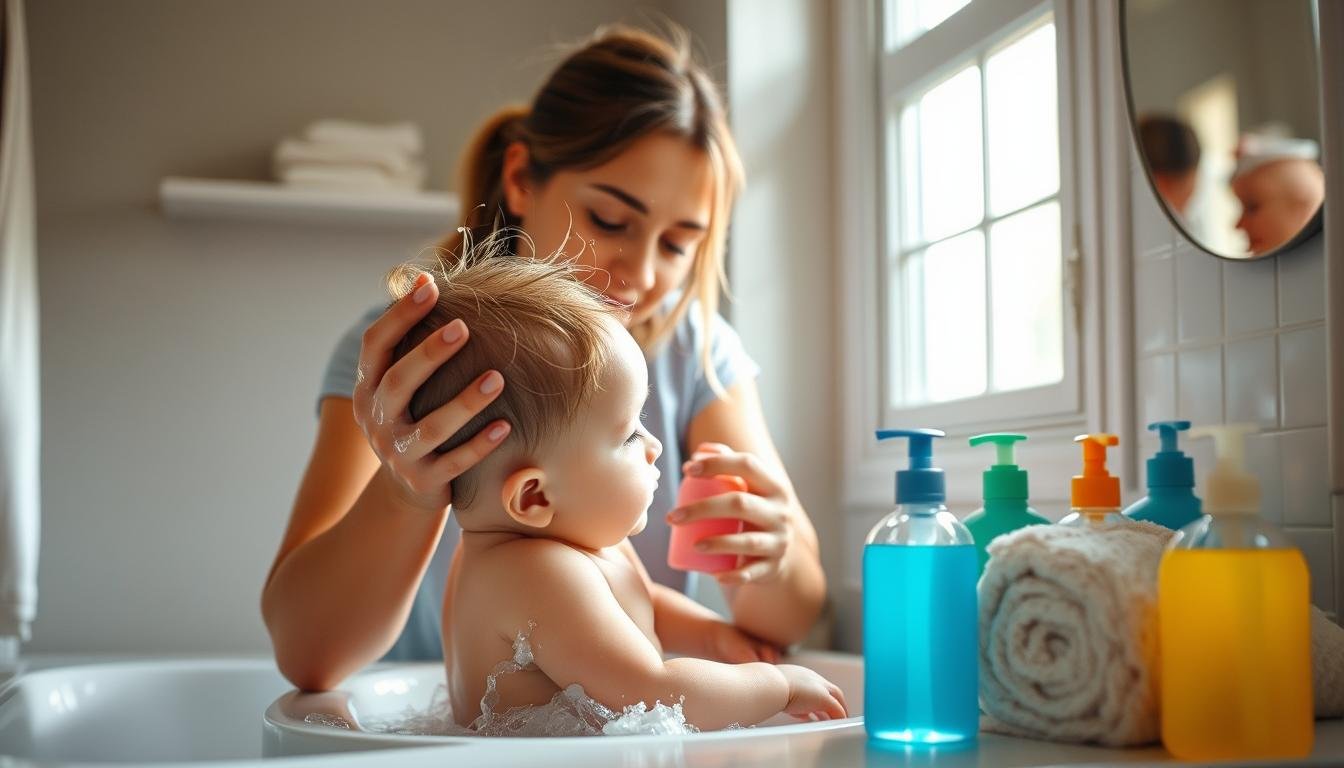How to Care for Baby and Toddler Hair: Expert Tips
Did you know that most babies experience hair loss between 2 and 3 months of age? Despite this Common occurrence, caring for a baby or toddler’s delicate locks requires special attention to ensure healthy growth and development. As a professional copywriting journalist, I’ve gathered Expert insights to help you navigate the unique challenges and considerations of baby and toddler Hair Care.
Key Takeaways:
- Pediatricians recommend a weekly hair washing Routine for babies, increasing to twice a week if hair becomes oily
- Hair texture varies, with tightly curled hair potentially requiring less frequent washing compared to looser curls
- Avoid harsh scalp massaging during shampooing to prevent irritation
- Use baby-safe, minimal ingredient products in the first year to protect sensitive skin
- Fingers are the best tools for gently detangling a baby’s hair to preserve natural curl patterns
Understanding Baby and Toddler Hair Types
The hair types of infants and toddlers can vary widely, ranging from fine and thin to thick and curly. Lanugo, a fine layer of hair that forms in the womb, usually sheds before or shortly after birth. Baby hair is typically soft, delicate, and sensitive to care.
Common Hair Types in Infants and Toddlers
Hair types in children can be broadly classified into four main categories: straight (Type 1), wavy (Type 2), curly (Type 3), and coily/kinky (Type 4). Each type has specific subcategories with distinct characteristics and care requirements. The texture of a child’s hair can range from fine and thin to coarse and thick, influencing the products and routines needed for their Hair Care.
Key Characteristics of Baby Hair
Baby hair is often soft, fine, and delicate, requiring gentle care. Factors like curl pattern, density, and porosity play a crucial role in determining the appropriate hair care regime. Proper detangling methods, such as using wide-toothed combs, are essential to minimize breakage and maintain hair health.
Transitioning to Toddler Hair
As babies grow into toddlers, their hair may change in texture, thickness, and color due to hormonal changes and genetics. Some toddlers are born with tightly curled hair patterns, while others have looser curls or straight hair. Hair texture can differ even among siblings. Understanding a child’s specific hair type helps in selecting appropriate natural hair products for their care and styling.
| Hair Type | Characteristics | Care Recommendations |
|---|---|---|
| Straight (Type 1) | Lies flat against the scalp with no noticeable curl or wave | Gentle cleansing and conditioning |
| Wavy (Type 2) | Features loose waves falling between straight and curly | Mild shampoo and conditioner, avoid over-brushing |
| Curly (Type 3) | Forms spirals or corkscrew-shaped curls | Hydrating shampoos and deep conditioning treatments |
| Coily/Kinky (Type 4) | Has tight, springy curls | Moisture-rich products and gentle detangling |
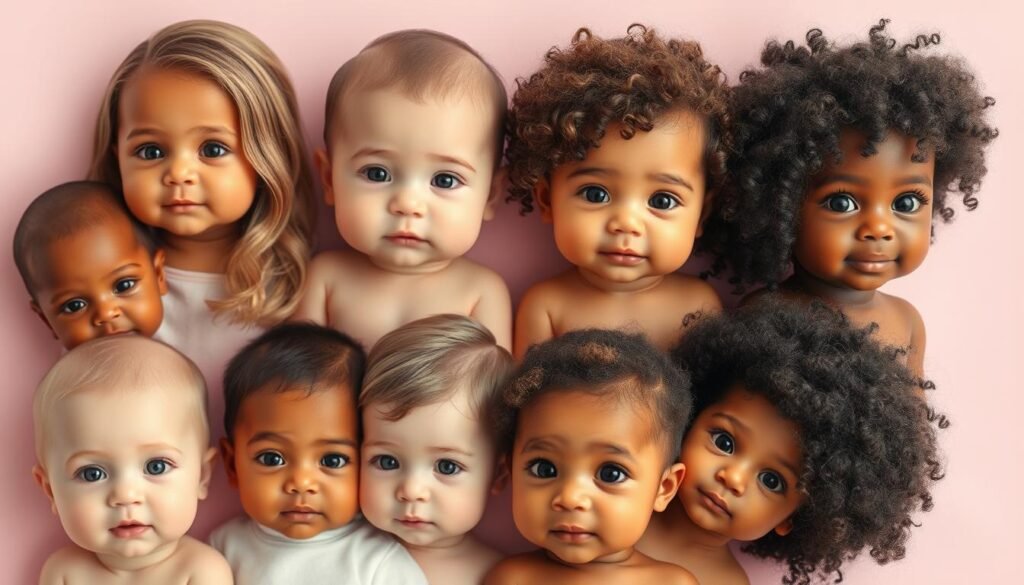
Understanding a child’s hair type and characteristics is crucial for providing the right hair care and ensuring their hair remains healthy and strong as they grow.
Essential Hair Care Products for Young Children
When it comes to caring for baby and toddler hair, it’s crucial to choose the right products that are gentle, effective, and tailored to their delicate needs. From shampoos and conditioners to detanglers and accessories, the right hair care items can make all the difference in maintaining healthy, manageable locks.
Choosing the Right Shampoo and Conditioner
Look for shampoos and conditioners that are specifically formulated for babies and toddlers. Opt for sulfate-free, gentle formulas that won’t strip their hair and scalp of natural oils. Products like JOHNSON’S® No More Tangles™ Kids Shampoo or JOHNSON’S® Shiny Drops Kids Shampoo are excellent choices, as they provide a thorough cleansing without causing irritation.
Importance of Sulfate-Free Products
Sulfates, commonly found in many adult hair care products, can be harsh on delicate baby and toddler hair. Sulfate-free formulas are gentler and help to maintain the hair’s natural moisture and shine. This is especially important for young children, whose scalps and strands are more sensitive to harsh chemicals.
Detanglers and Other Helpful Accessories
Detangling can be a challenging task for little ones, but the right products can make the process much easier. Consider using a JOHNSON’S® No More Tangles™ Kids Conditioner Spray or JOHNSON’S® Shiny Drops Kids Conditioner Spray to help glide through knots and tangles with ease. A wide-tooth comb or a soft-bristle brush can also be invaluable tools for gentle, effective detangling.
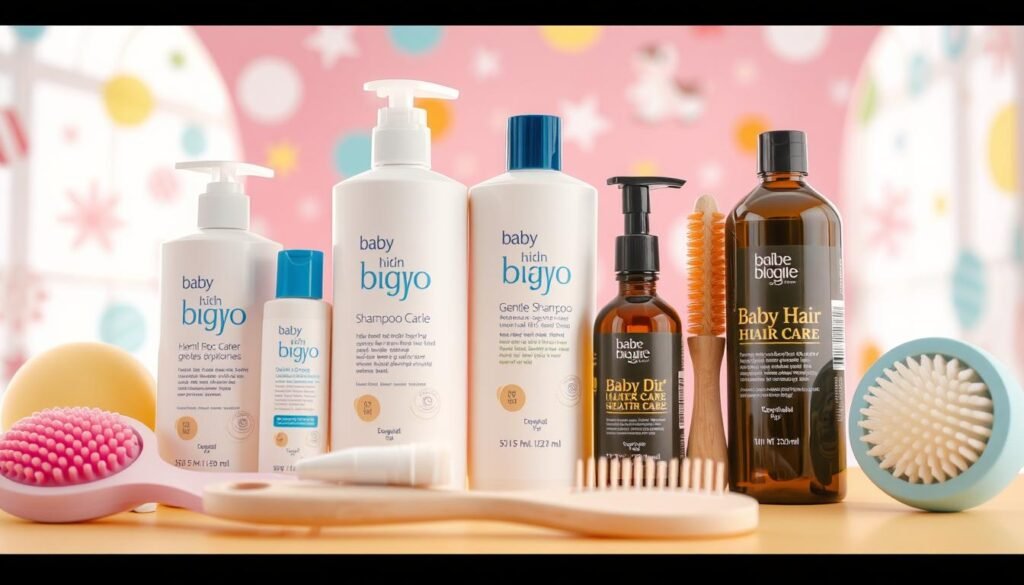
By incorporating these essential hair care products into your Routine, you can ensure that your little one’s hair remains healthy, manageable, and free of unwanted frizz and static cling. Remember to choose products that are specifically formulated for babies and toddlers, and always prioritize gentle, sulfate-free formulas to protect their delicate tresses.
How Often to Wash Baby and Toddler Hair
When it comes to caring for your little one’s delicate locks, the frequency of washing can make a significant difference. According to experts, the recommended washing Routine varies based on the child’s age and hair type.
Guidelines for Different Hair Types
For newborns, the guidance suggests starting with a gentle cleansing routine of dabbing their hair with warm water and cotton wool for the first three months. As infants reach 1-2 months of age, pediatricians advise bathing them one to two times a week, as their hair follicles produce minimal oil.
As your child transitions to a toddler, the washing frequency may increase to 2-3 times per week, depending on their activity levels and exposure to dirt and sweat. It’s essential to use a gentle, baby-specific shampoo, like the Mini Mio Oh So Clean Foaming Wash, formulated by dermatologists with a Skin Nurturing Omega Complex.
Signs That Your Child’s Hair Needs Washing
The frequency of washing your baby or toddler’s hair should also be guided by visible signs that their locks need attention. These may include a visible buildup of dirt, an oily appearance, or an unpleasant odor. Overwashing, however, can strip the natural oils from their delicate hair, especially for those with dry or curly textures.
To maintain a healthy balance, it’s recommended to adjust the washing frequency based on your child’s individual needs and consult with a pediatrician if you’re unsure about the appropriate routine.
“The frequency of washing babies’ hair is advised to be one to two times a week to maintain cleanliness and offer a soothing experience.”

By following these guidelines and paying attention to your child’s hair, you can ensure that their locks stay clean, healthy, and nourished throughout their early years.
Tips for Gentle Washing Techniques
When it comes to caring for your baby or toddler’s delicate hair, gentle washing techniques are crucial. The key is to approach hair washing with a soft, nurturing touch that prioritizes your child’s comfort and safety.
Best Practices for Bath Time
Start by using lukewarm water, which is more soothing than hot or cold temperatures. Gently massage your child’s scalp with your fingertips, avoiding any harsh scrubbing that could irritate the skin. Remember to shield your little one’s eyes when rinsing to prevent shampoo from entering and causing discomfort.
For efficient yet gentle rinsing, consider using a small cup or a handheld shower attachment. Carefully pour water over your child’s hair, allowing it to flow away from their face. Pat the hair dry with a soft towel, being mindful not to rub vigorously, which can damage delicate strands.
How to Hold and Support Your Child
- Provide a secure and comfortable hold during the washing process, supporting your child’s head and neck to ensure their safety and well-being.
- Engage your little one with playful distractions, such as singing songs or using bath toys, to help them feel at ease and enjoy the experience.
- If your child becomes distressed, pause the hair washing and offer reassurance until they feel ready to continue.
By incorporating these gentle baby hair washing techniques and gentle hair care for infants, you can create a calming and enjoyable bathing experience for both you and your child.
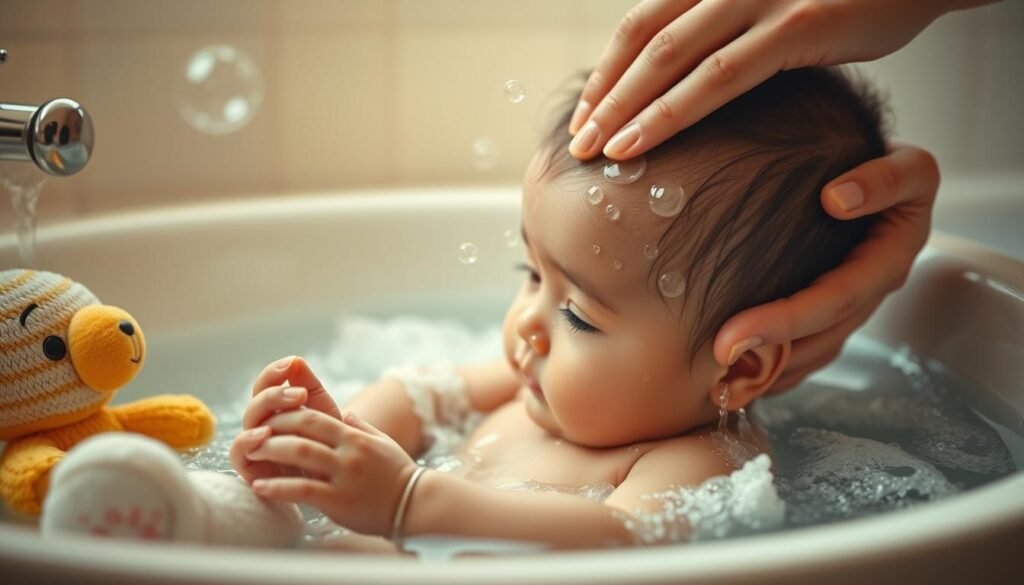
Drying Hair Safely and Effectively
As a parent, ensuring your baby or toddler’s hair is dried properly is crucial to maintaining its health and preventing damage. When it comes to drying techniques, there are a few key methods to consider.
Recommended Towel Techniques
The gentlest approach is to pat your child’s hair dry with a soft, absorbent towel. Avoid rubbing the hair vigorously, as this can lead to frizz and breakage. For curly-haired little ones, consider using a microfiber towel or an old t-shirt to minimize frizz and maintain the natural texture.
Air Drying vs. Using a Hairdryer
Air drying is often the most gentle option for drying baby and toddler hair. If you do need to use a hairdryer, be sure to use the lowest heat setting and keep the dryer at least 6 inches away from your child’s scalp. Overexposure to heat can cause dryness and damage to their delicate strands.
One parent shared, “My 4-year-old loves when I blow-dry her hair, but I always make sure to keep the heat on the lowest setting and move the dryer around to prevent any hot spots.”
When possible, allow your child’s hair to air dry to maintain its natural texture and prevent heat-related issues. This is especially important for babies and toddlers with fragile, fine hair.
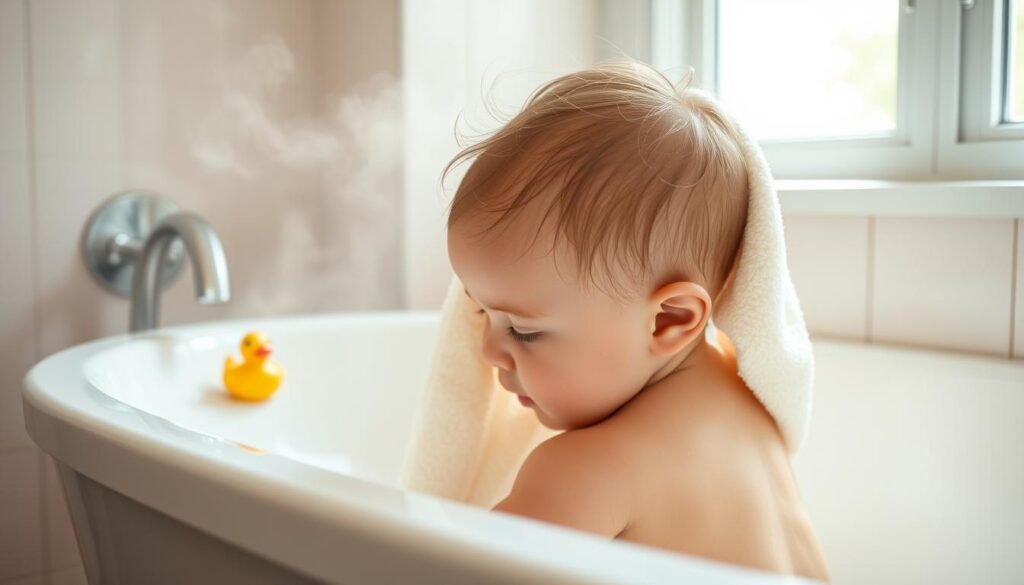
By following these gentle drying techniques, you can help keep your little one’s hair healthy and strong as it grows.
Styling Options for Babies and Toddlers
Caring for your little one’s delicate locks goes beyond just washing and drying. Styling their hair can be a fun and creative way to keep it looking neat and tidy. However, it’s crucial to approach baby and toddler hairstyles with caution, ensuring safety and comfort.
Simple and Safe Hairstyles
When it comes to baby hairstyles and toddler hair styling, simplicity is key. Opt for loose, gentle styles that won’t pull or tug on the hair and scalp. Soft, fabric-covered elastics are ideal for creating ponytails or pigtails, as they won’t cause discomfort or breakage. Avoid tight hairstyles like cornrows or braids, as they can lead to a condition called traction alopecia.
For curly-haired little ones, finger-combing is a gentle way to maintain their natural curl pattern. Steer clear of using heated tools like irons or blow dryers, as their delicate hair can’t withstand the heat.
Avoiding Hair Accessories That Can Cause Harm
While safe hair accessories for infants can add a touch of style, it’s important to use them sparingly and with caution. Opt for clips and bows without small parts that could pose a choking hazard. Always supervise your child when using any hair accessories to ensure their safety.
Remember, the goal is to keep your baby or toddler’s hairstyles simple, comfortable, and enjoyable for both of you. By following these guidelines, you can help your little one look and feel their best without compromising their health and wellbeing.
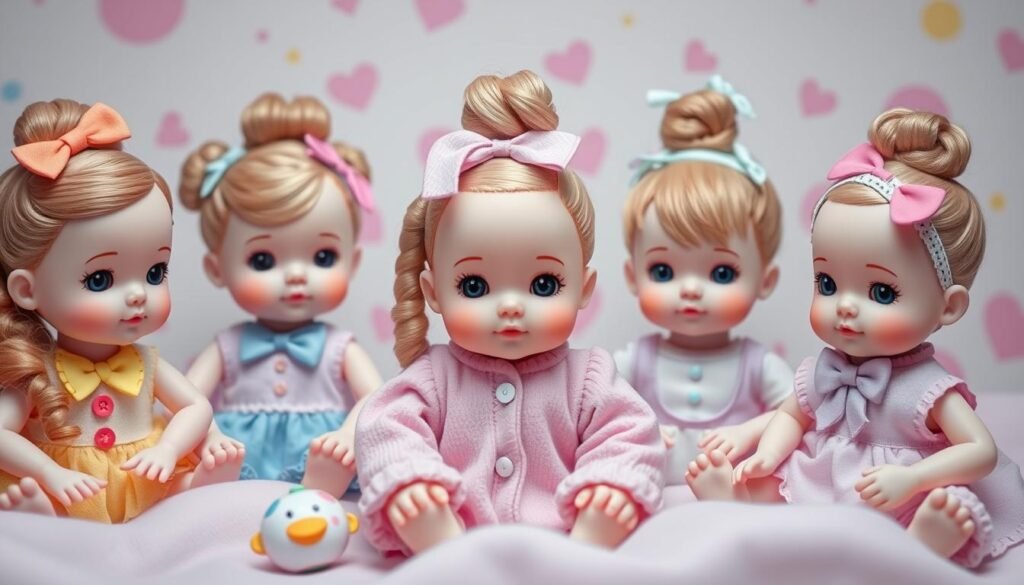
common hair Issues and Solutions
Raising a baby or toddler can come with its fair share of hair-related challenges. From cradle cap to tangled tresses, it’s important to address these common hair issues with gentle, effective solutions. Let’s dive into how to manage these concerns and keep your little one’s locks looking and feeling their best.
Dealing with Cradle Cap
Cradle cap, a yellowish, crusty rash on the scalp, is a Common condition that affects many infants. To treat cradle cap, gently shampoo your baby’s scalp with a mild, cradle cap-specific shampoo. Lightly brushing the scalp with a soft-bristle brush can help loosen and remove the flaky skin. If the condition persists, apply a small amount of mineral oil to the scalp, let it sit for a few minutes, then shampoo to remove the buildup.
Managing Tangled Hair
Detangling baby and toddler hair can be a challenge, but with the right techniques, you can make it a much smoother process. When hair is wet, use a wide-tooth comb or your fingers to gently work through tangles, starting at the ends and working your way up towards the roots. For very curly or coily hair, consider sectioning the hair before detangling to make the process easier and less painful for your little one. A detangling spray or leave-in conditioner can also help ease the process.
Caring for your child’s hair doesn’t have to be a daunting task. By addressing common issues like cradle cap and tangled hair with the right strategies, you can keep their locks healthy, happy, and manageable.
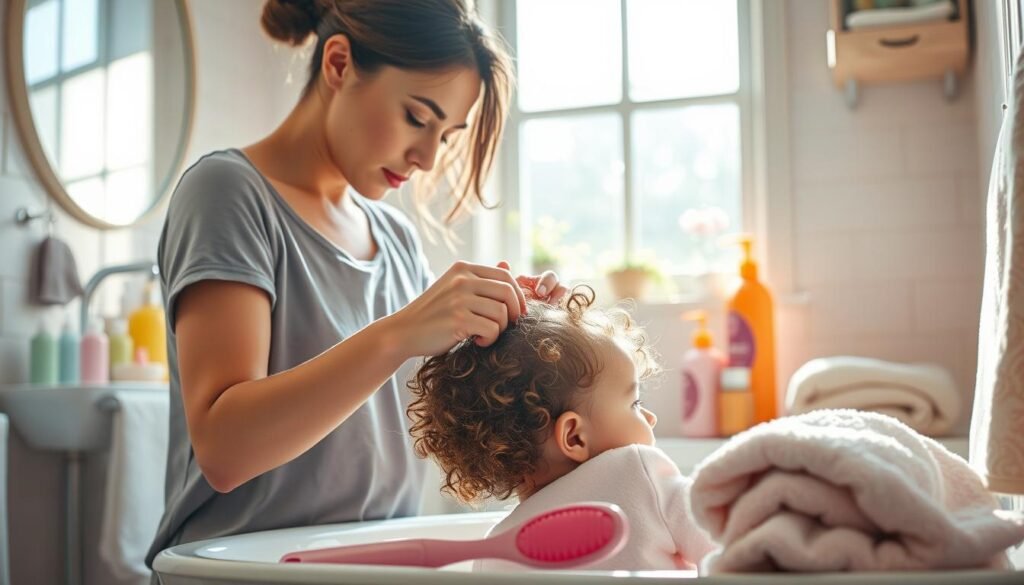
Nutrition and Its Impact on Healthy Hair
Achieving luscious locks for your baby or toddler starts with a balanced diet. Proper nutrition plays a crucial role in promoting healthy hair growth and maintenance. By incorporating the right foods, you can nourish your child’s hair from the inside out.
Foods that Promote Healthy Hair Growth
To support your little one’s hair health, focus on incorporating the following nutrient-dense foods into their diet:
- Eggs, which are rich in biotin, a B-vitamin essential for hair growth
- Fatty fish like salmon, packed with omega-3 fatty acids that nourish the scalp
- Sweet potatoes, a great source of vitamin A that helps produce sebum to keep hair hydrated
- Leafy greens such as spinach and kale, high in iron and vitamins A, C, and E
Importance of Hydration
Proper hydration is just as crucial for healthy hair as a balanced diet. Ensure your baby or toddler drinks plenty of water throughout the day, especially as they become more active. Adequate hydration helps maintain a healthy scalp and supports the overall condition of their hair.
| Nutrient | Benefits for Hair |
|---|---|
| Biotin | Supports hair growth and strength |
| Omega-3 Fatty Acids | Nourish the scalp and promote hair health |
| Vitamin A | Helps produce sebum to keep hair hydrated |
| Iron | Vital for healthy hair growth and preventing Hair Loss |
By focusing on a nutrition for baby hair growth and toddler diet for healthy hair, you can help ensure your child’s hair develops and thrives. Consistent hydration and a balanced diet rich in the right nutrients will set the foundation for beautiful, healthy hair.
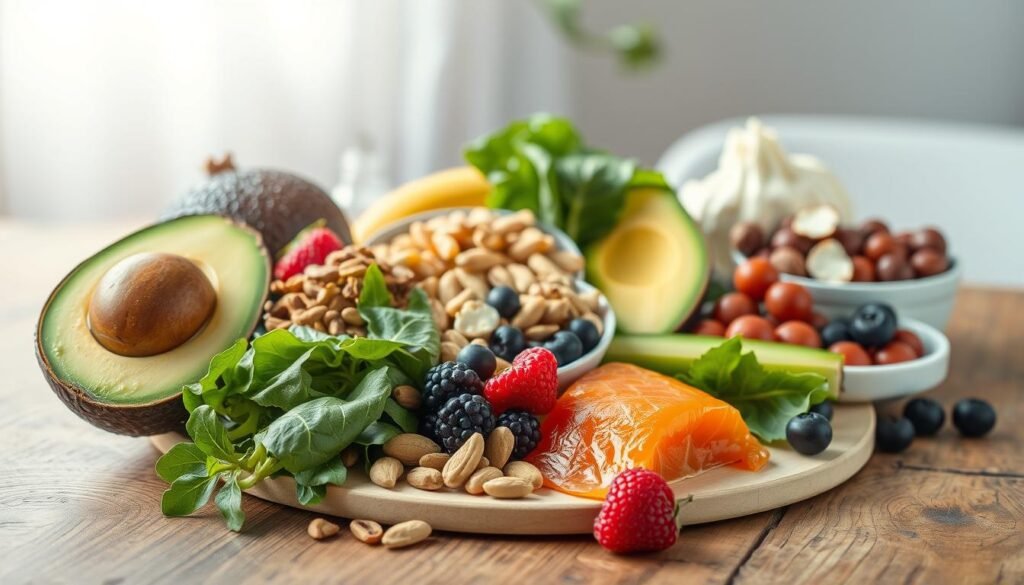
When to Consult a Professional
While caring for your child’s hair at home can be manageable, there may be times when it’s best to seek the expertise of a professional. If you notice excessive hair loss, bald patches, or persistent scalp issues like severe cradle cap or eczema, it’s advisable to consult a pediatric dermatologist.
Signs Your Child May Need a Dermatologist
If your child’s hair isn’t growing by the time they reach 18 months of age, it’s important to have them evaluated by a healthcare provider. Sudden changes in hair texture, color, or growth patterns may also warrant a visit to a specialist.
Finding a Pediatric Hair Specialist
Look for pediatric dermatologists or trichologists who specialize in children’s hair and scalp health. Regular check-ups with your child’s pediatrician can also help monitor their overall hair growth and development. If you have any concerns about your child’s hair, don’t hesitate to discuss them with a healthcare professional.
FAQ
What are the Common Hair types in infants and toddlers?
Baby hair types vary widely, from fine and thin to thick and curly. Lanugo, a thin layer of hair that appears in the womb, usually sheds before or shortly after birth. Baby hair is typically soft and delicate. As babies transition to toddlers, their hair may change in texture, thickness, and color due to hormonal changes and genetics.
What are the key characteristics of baby hair?
Baby hair is typically soft and delicate. Some babies are born with tightly curled hair patterns, while others have looser curls or straight hair. Hair texture can differ among siblings.
How do I choose the right shampoo and conditioner for my baby or toddler?
Use gentle, sulfate-free shampoos specifically designed for babies to avoid stripping natural oils. Look for products with minimal ingredients to protect sensitive scalps. Natural oils like coconut, almond, or jojoba can be used for moisturizing.
How often should I wash my baby or toddler’s hair?
Washing frequency depends on hair type and texture. For most babies, once or twice a week is sufficient. Babies with oily hair may need more frequent washing. Signs that hair needs washing include visible dirt, oily appearance, or unpleasant odor.
What are the best practices for gently washing my child’s hair?
Use lukewarm water for washing. Gently massage the scalp with fingertips, avoiding harsh scrubbing. Support your baby’s head and neck during washing. Shield eyes when rinsing to prevent shampoo from entering. Use a small cup or handheld shower attachment for rinsing.
How should I dry my baby or toddler’s hair?
Gently pat hair dry with a soft towel to avoid breakage. Air drying is the gentlest method for baby hair. If using a hairdryer, use the lowest heat setting and keep it at least 6 inches away from the scalp.
What are some safe and simple hairstyles for babies and toddlers?
Keep hairstyles simple and loose to avoid pulling on delicate hair and scalp. Use soft, fabric-covered elastics for ponytails or pigtails. Avoid tight hairstyles like cornrows or braids for babies, as they can cause traction alopecia.
How can I manage cradle cap and tangled hair in my child?
Treat cradle cap with gentle shampooing and light brushing. For persistent cases, apply mineral oil before washing. To manage tangles, use a wide-tooth comb or fingers to gently detangle wet hair, starting from the ends and working up to the roots.
How does nutrition impact my child’s hair health?
A balanced diet rich in proteins, vitamins, and minerals promotes healthy hair growth. Foods high in biotin, iron, and omega-3 fatty acids are particularly beneficial. Adequate hydration is crucial for maintaining healthy hair and scalp.
When should I consult a professional for my child’s hair concerns?
Consult a professional if you notice excessive hair loss, bald patches, or persistent scalp issues like severe cradle cap or eczema. Seek medical advice if your child’s hair doesn’t grow by 18 months of age. Look for pediatric dermatologists or trichologists who specialize in children’s hair and scalp health.
